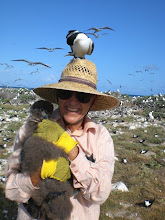Several people have asked about food and how we eat. We don't have anything local which is too bad but understandable. Tern Island is now designated as part of a National Monument and there is no fishing or harvesting of any wildlife, so all of our food is brought in. We have 2 large freezers full of frozen meats, vegetables, bread, bagels, and fruit. We have several refrigerators for leftovers, bread, condiments and cold drinks, mostly Tang and iced tea. We have a large pantry area with all the dry and prepared food. Most of the food tends toward basic ingredients that need to be but together into a meal. Not pot pies or TV dinners. We have fresh fruits and vegetables for a couple of weeks after each visit by a ship then we move on to more frozen or canned fruit and vegetables. We have a large variety of cold and hot cereals for breakfast and a good selection of sandwich stuff for lunches. Breakfast and lunch are on your own and Dinner is cooked on a rotating basis and you cook for all 10 people. That has been a daunting task for me. I have relied heavily on Jan and Hannah for ideas and I am now team cooking with one of the other volunteers so we cook more often but we have 2 people working on our nights to cook instead of 1. Everyone seems to cook more than is needed and leftovers become popular lunch fare. This week we had pasta one night, a stir fry another night, and tonight had all the fixings for roll your own burrito. The food has been pretty good.




